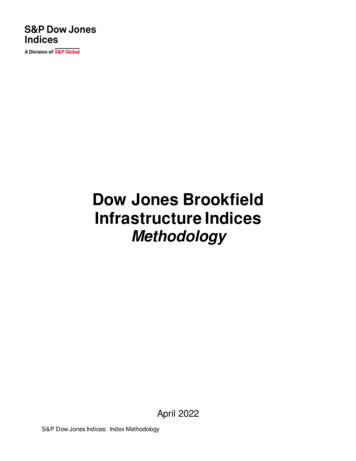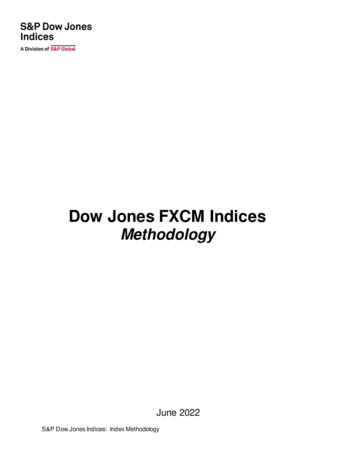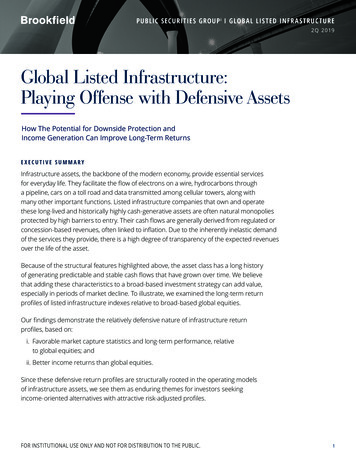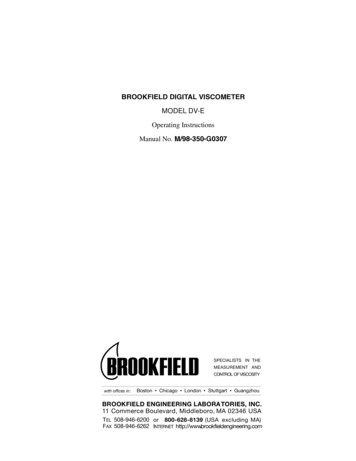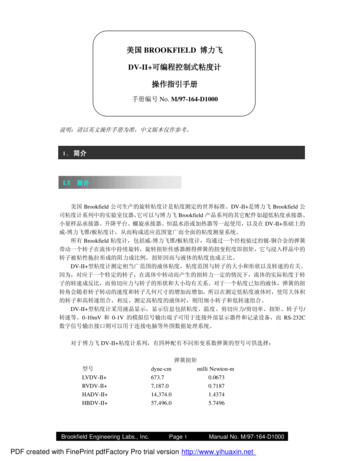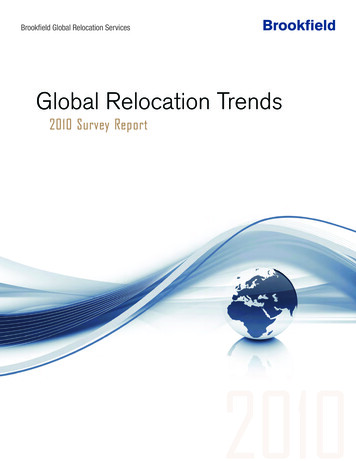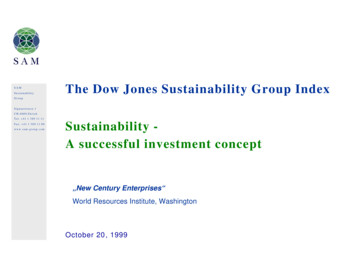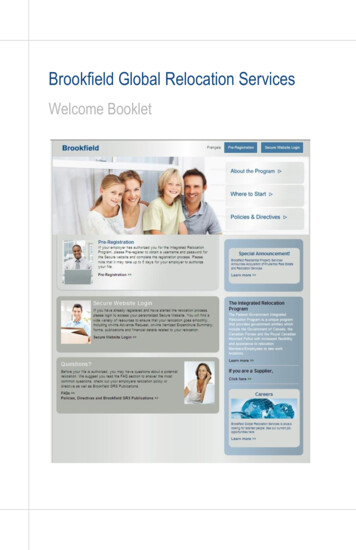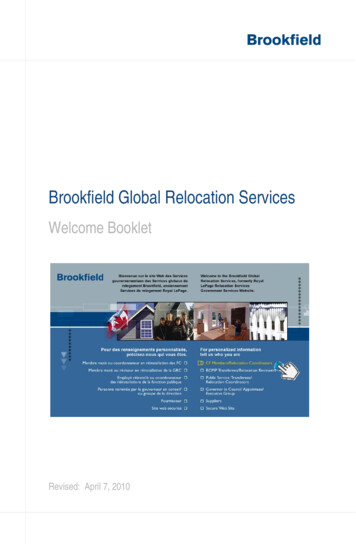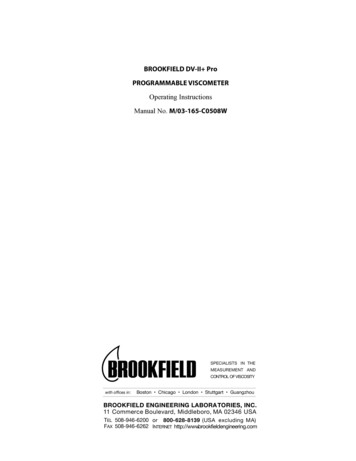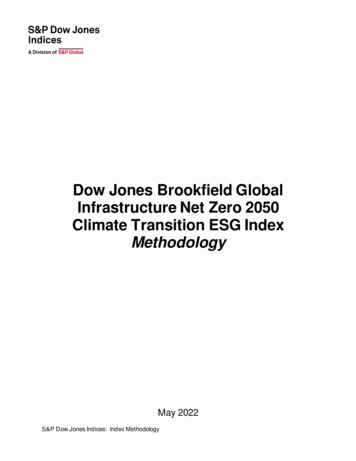
Transcription
Dow Jones Brookfield GlobalInfrastructure Net Zero 2050Climate Transition ESG IndexMethodologyMay 2022S&P Dow Jones Indices: Index Methodology
Table of ContentsIntroduction4Index Objective4Highlights4Climate-Related Data5Trucost’s Transition Pathway Model5Trucost’s Physical Risk Data6Science Based Target Initiative (SBTI)6The S&P DJI ESG Score6Supporting Documents7Eligibility Criteria8Index Universe8Eligibility Factors8Index Exclusions8Exclusions Based on Business Activities8Exclusions Based on Sustainalytics’ Global Standards Screening9Controversies Monitoring: Media and Stakeholder Analysis Overlay10Multiple Classes of Stock10Index Construction11Constituent Selection11Constituent Weighting11Optimization Constraints11Table 1. Transition Risk Constraints11Table 2. Physical Risk Constraints12Table 3. Climate Opportunities Constraint12Table 4. Index Construction Constraints12Constraint Relaxation Hierarchy13Constraint-Related Definitions131.5ºC Climate Scenario Transition Pathway Budget Index Alignment13Weighted-Average Carbon Intensity (WACI)14Eligible Science Based Targets14High Climate Impact Sectors Revenue Proportion (HCISRP)14Non-Disclosing Carbon Companies15Fossil Fuel Reserves (FFR)15S&P Dow Jones Indices: DJ Brookfield Global Infrastructure Net Zero 2050 Climate Transition Index Methodology1
Green-to-Brown Revenue Share (GBR)15Index Calculations16Index Maintenance17Rebalancing17Ongoing Maintenance17Quarterly Updates17Additions and Deletions17Corporate Actions17Currency of Calculation and Additional Index Return Series18Base Dates and History Availability18Index Data19Calculation Return TypesIndex GovernanceIndex CommitteeIndex Policy19202021Announcements21Pro-forma Files21Holiday Schedule21Rebalancing21Unexpected Exchange Closures21Recalculation Policy21Contact Information21Index Dissemination22Tickers22Index Data22S&P DJI ESG Scores Data22Website22Appendix I23Physical Risk Max Stock Weight ConstraintAppendix II23251.5ºC Climate Scenario Transition Pathway Budget Index Alignment Constraint 25Table 5. Transition Pathway Budget Alignment Value Calculation ExampleAppendix III2627Trucost MethodologyAppendix IV2728Methodology ChangesAppendix VS&P Dow Jones Indices: DJ Brookfield Global Infrastructure Net Zero 2050 Climate Transition Index Methodology28292
Index Anchor Date of Decarbonization TrajectoryAppendix VI2930Backward Data Assumption30Designated Datasets Subject to Backward Data Assumption30Appendix VII31Indices in this Methodology with Historical Back-Test Rule DeviationsAppendix VIII3132EU Required ESG DisclosuresDisclaimer3236Performance Disclosure/Back-Tested Data36Intellectual Property Notices/Disclaimer37S&P Dow Jones Indices: DJ Brookfield Global Infrastructure Net Zero 2050 Climate Transition Index Methodology3
IntroductionIndex ObjectiveThe Dow Jones Brookfield Global Infrastructure Net Zero 2050 Climate Transition ESG Index measuresthe perf ormance of eligible equity securities from an underlying parent index selected and weighted to becollectively compatible with a 1.5ºC global warming climate scenario1 at the index level. The index appliesexclusions based on companies’ involvement in specific business activities, performance against theprinciples of the United Nations’ Global Compact (UNGC), and involvement in relevant ESGcontroversies, all outlined in Eligibility Criteria.HighlightsThe index aims to meet the minimum standards for EU Climate Transition Benchmarks (EU CTBs) underRegulation (EU) 2019/2089 amending Regulation (EU) 2016/10112. The law proposes the definitions ofminimum standards for the methodology of any ‘EU Climate Transition’ benchmark indices that would bealigned with the objectives of the Paris Agreement3, and addresses the risk of greenwashing. The indexalso incorporates factors that seek to manage transition risk and climate change opportunities in a waythat aligns them with the recommendations of the Financial Stability Board’s Task Force on Climaterelated Financial Disclosures’ (TCFD) 2017 Final Report 4, covering transition risk, and climate changeopportunities.Should a material change to the methodology be required as a consequence of any change made by theEU to the minimum standards for EU CTBs, S&P Dow Jones Indices will issue an announcement beforethe change is implemented (and in these circumstances, S&P Dow Jones Indices would not conduct af ormal consultation). For clarity, any other methodology change will follow S&P Dow Jones Indices’standard processes, which may include a consultation.The index weighting strategy aims to minimize the difference in constituent weights to the underlyingparent index. In addition, the index incorporates a variety of specified decarbonization targets and alignwith certain specified criteria through the use of optimization with multiple model constraints, including: alignment to a 1.5ºC climate scenario using the S&P Trucost Limited (Trucost) TransitionPathway Model reduced overall greenhouse gas (GHG expressed in CO2 equivalents) emissions intensitycompared to their respective underlying parent index by at least 30% minimum self-decarbonization rate of GHG emissions intensity in accordance with the trajectoryimplied by Intergovernmental Panel on Climate Change’s (IPCC) most ambitious 1.5ºC scenario,equating to at least 7% GHG intensity reduction on average per annum increased exposure to companies with Science Based Targets from the Science Based TargetInitiative (SBTI) that are credible and consistent with the above decarbonization trajectory1A climate scenario of 1.5ºC above preindustrial levels has been deemed important by the IPCC: Masson -Delmotte, V., Zhai, P.,Pörtner, H. O., Roberts, D., Skea, J., Shukla, P. R. Waterfield, T. (2018). Global warming of 1.5 C. An IPCC Special Report o n theimpacts of global warming of 1.5 C. IPCC, available at https://www.ipcc.ch/sr15/.2Pursuant to Articles 19(a)(2) and 19(b)(1) of Regulation (EU) 2019/2089, Commission Delegated Regulation (EU) 2020/1818 laysdown the minimum standards for EU CTBs and EU PABs https://eur-lex.europa.eu/legalcontent/EN/TXT/?uri CELEX:32020R1818.3UNFCCC. (2015). The Paris Agreement: agreement/the-paris-agreement.4Financial Stability Board’s Task Force on Climate-related Financial Disclosures’ (TCFD). (2017). Final Report: Recommendationsof the Task Force on Climate-related Financial Disclosures, available at /FINAL-2017-TCFD-Report-11052018.pdf.S&P Dow Jones Indices: DJ Brookfield Global Infrastructure Net Zero 2050 Climate Transition Index Methodology4
improved S&P DJI ESG Score (further defined further below) compared to the parent index exposure to sectors with high impact on climate change at least equivalent to the parent index managed exposure to potential climate change opportunities through controlled green-to-brownrevenue share in order to align with the recommendations of the TCFD capped exposure to non-disclosing carbon companies constituent-level weight capping to address liquidity and diversificationThe index f eatures the exclusion of companies from the underlying parent index with: involvement in controversial weapons, tobacco, thermal coal, and Arctic Oil & Gas Explorationactivities non-compliant United Nations Global Compact (UNGC) principle violations involvement in relevant ESG controversiesClimate-Related DataTrucost’s Transition Pathway ModelThe Trucost Transition Pathway approach is based on two models: the Sectoral DecarbonizationApproach (“SDA”) (Krabbe, et al., 2015)5, and the Greenhouse Gas Emissions per unit of Value AddedApproach (“GEVA”) (Randers, 2012)6, which are both recommended by the Science Based TargetsInitiative (Science Based Targets Initiative, 2019).7The approach allows for a f orward-looking perspective on likely future greenhouse gas emissions, anduses a carbon budget allocation method to allocate each company a total amount of carbon emissionsper year. These allocations allow companies, as a collective, to be 1.5 C aligned provided their emissionsremain within the allocation budgets.The SDA approach is sector specific and is used for high emitting sectors.8 The SDA uses carbonintensity based on sector specific measures of output. For example, the unit of output for iron and steelcompanies is “tCO2 per ton crude steel”. This allows an understanding of how carbon efficient companiesare per unit of output. The SDA approach also sets carbon budgets for specific sectors as a whole, whichallows some sectors to decarbonize more slowly where the opportunities for decarbonization are farlower. This is allowed by setting more aggressive targets for sectors with greater scope fordecarbonization.GEVA is applied to lower emitting or heterogeneous business activities. For GEVA, the unit of outputused is gross profit. Companies have diverse business activities, most of which do not have distincttransition pathways defined in climate scenarios. For these companies, the methodology applies acontraction in carbon intensity principle under which a company should make emissions reductions. Thisis consistent with rates required for the overall economy, but from each company’s unique base yearemissions intensity.5Krabbe, O., Linthorst, G., Blok, K., Crijns-Graus, W., van Vuuren, D., Höhne, N., Pineda, A. C. (2015). Aligning CorporateGreenhouse-Gas Emissions Targets with Climate Goals. Nature Climate Change.Randers, J. (2012). Greenhouse gas emissions per unit of value added (“GEVA”) – A corporate guide to voluntary climate action.Journal Energy Policy.7Science Based Targets Initiative. (2019, April). Science -Based Target Setting Manual, available ds/2017/04/SBTi-manual.pdf.8As referenced in section 5.7.2. of The EU Technical Expert Group on Sustainable Finance. (2019). TEG Final Report on ClimateBenchmarks and Benchmarks’ ESG Disclosures, available at sclosures en.6S&P Dow Jones Indices: DJ Brookfield Global Infrastructure Net Zero 2050 Climate Transition Index Methodology5
Trucost’s Physical Risk DataTrucost’s Physical Risk dataset9 allows users to understand the risk and sensitivity of company assets tothe physical risks of climate change. Climate modelling datasets and hazard models are overlaid with theasset locations of companies. Sensitivity analysis is carried out for each asset, to assess whether thecompany’s operations would be affected by each specific physical risk, based on the asset type.10These climate modelling datasets and hazard models have been created for each specific physical risk.Physical risk is judged by a score ranging between 1 and 100. The physical risks covered are: wildfire,cold wave, heatwave, water stress, sea level rise, flood and hurricanes. The index methodology uses acomposite physical risk score that is an average of all 7 physical risk indicators, weighted for companyspecific sensitivity to each physical risk type.Other Trucost Data Used: GHG Emissions, Emissions Disclosure Status, Green-to-Brown Share, FossilFuel Reserves, and Sector Revenues.Please refer to Appendix III for the Trucost Methodology, and http://www.trucost.com/ for moreinformation on Trucost generally.Science Based Target Initiative (SBTI)The Science Based Targets initiative champions science-based target setting as a powerful way ofboosting companies’ competitive advantage in the transition to a low-carbon economy. The initiative is acollaboration between CDP, World Resources Institute (WRI), the World Wide Fund for Nature (WWF),and the United Nations Global Compact (UNGC).Targets adopted by companies to reduce greenhouse gas (GHG) emissions are considered “sciencebased” if they are in line with what the latest climate science says is necessary to meet the goals of theParis Agreement—to limit global warming to well-below 2 C above pre-industrial levels and pursue effortsto limit warming to 1.5 C.For more information on the initiative, please refer to https://sciencebasedtargets.org/.The S&P DJI ESG ScoreThe S&P DJI ESG Score is built from S&P Global’s ‘Corporate Sustainability Assessment’ (CSA). Acompany’s S&P DJI ESG score may either be calculated from data received directly by a companycompleting the comprehensive assessment (together with supporting documents), or – in the absence ofthis – by using publicly available information. S&P Global uses the CSA results to then calculate the S&PDJI ESG Scores.For more information on the CSA Process, please refer to https://www.spglobal.com/esg/csa/.For more information on S&P DJI ESG Scores, please refer to the S&P DJI ESG Score Methodology.For the purposes of ESG assessment, companies are assigned to industries defined by S&P Global, andthe assessment is largely specific to each industry. S&P Global uses the Global Industry ClassificationStandard (GICS ) as its starting point for determining industry classification. At the industry group andsector levels, the S&P Global CSA Industries match the standard GICS classifications, but some nonstandard aggregations are done at the industry level.For information on S&P Global CSA Industry-GICS Sub-Industry Mapping, please see here.9The 2050 High Climate Scenario is used.Lord. R, Bullock, S. Birt, M. (2019). ‘Understanding Climate Risk at the Asset Level: The Interplay of Transition and PhysicalRisks’. ical-risk-report05a.pdf.10S&P Dow Jones Indices: DJ Brookfield Global Infrastructure Net Zero 2050 Climate Transition Index Methodology6
Supporting DocumentsThis methodology is meant to be read in conjunction with supporting documents providing greater detailwith respect to the policies, procedures and calculations described herein. References throughout themethodology direct the reader to the relevant supporting document for further information on a specifictopic. The list of the main supplemental documents for this methodology and the hyperlinks to thosedocuments is as follows:Supporting DocumentS&P Dow Jones Indices’ Equity Indices Policies& Practices MethodologyS&P Dow Jones Indices’ Index MathematicsMethodologyS&P Dow Jones Indices’ Float AdjustmentMethodologyS&P Dow Jones Indices’ Global IndustryClassif ication Standard (GICS) MethodologyS&P DJI ESG Score MethodologyURLEquity Indices Policies & PracticesIndex Mathematics MethodologyFloat Adjustment MethodologyGICS MethodologyS&P DJI ESG Score MethodologyThe methodology is created by S&P Dow Jones Indices to achieve the aforementioned objective ofmeasuring the underlying interest of each index governed by this methodology document. Any changes toor deviations from this methodology are made in the sole judgment and discretion of S&P Dow JonesIndices so that the index continues to achieve its o bjective.The Benchmark Administrator for the indices under this methodology is S&P DJI Netherlands B.V.S&P Dow Jones Indices: DJ Brookfield Global Infrastructure Net Zero 2050 Climate Transition Index Methodology7
Eligibility CriteriaIndex UniverseAt each rebalancing ref erence date, the following index is constructed from an Eligible Universeconsisting of the constituents of an underlying index, as defined below:Net Zero 2050 Climate Transition ESG IndexSeriesUnderlying IndexDow Jones Brookfield Global Inf rastructure Net Dow Jones Brookfield Global Inf rastructureZero 2050 Climate Transition ESG IndexFor information on an underlying index, please refer to the respective index methodology, available atwww.spglobal.com/spdji.Eligibility FactorsClosed-End Funds. Except for closed-end funds, all stocks are eligible.Index ExclusionsAt each rebalancing ref erence date, companies are excluded from the eligible universe based onBusiness Activities, UNGC Principle Violations, and Controversies (Media and Stakeholder Analysis).Exclusions Based on Business ActivitiesAs of each rebalancing reference date, companies with the following specific business activities areexcluded from the eligible universe:Sustainalytics ProductInvolvementControversial WeaponsTobaccoSustainalyticsCategoryof Involvement andDescriptionTailor Made andEssential: Thecompany is involvedin the core weaponsystem, orcomponents/servicesof the core weaponsystem that areconsidered tailormade and essentialf or the lethal use ofthe weapon.Production: Thecompanymanuf actures tobaccoproducts.RelatedProducts/Services:S&P DJISustainalyticsLevel ofInvolvement InvolvementProxyThresholdNAS&P DJISignificantOwnershipThreshold 0% 25% 0% 25% 10% 25%RevenueS&P Dow Jones Indices: DJ Brookfield Global Infrastructure Net Zero 2050 Climate Transition Index Methodology8
Sustainalytics ProductInvolvementThermal CoalArctic Oil & Gas ExplorationSustainalyticsCategoryof Involvement andDescriptionThe company suppliestobacco-relatedproducts/services.Retail: The companyderives revenues fromthe distribution and/orretail sale of tobaccoproducts.Power Generation:The companygenerates electricityf rom thermal coal.Extraction: Thecompany extractselectricity fromthermal coal.Extraction: Thecompany is involvedin oil and gasexploration in Arcticregions.S&P DJISustainalyticsLevel ofInvolvement InvolvementProxyThresholdS&P DJISignificantOwnershipThreshold 5% 25%Revenue 10%NotRelevantRevenue 10%NotRelevantRevenue 0%NotRelevantLevel of Involvement refers to the company’s direct exposure to such products, while SignificantOwnership indicates where the company has indirect involvement via some specified level of ownershipof a subsidiary company with involvement.These exclusions use business involvement datasets from Sustainalytics. Companies not covered bySustainalytics are excluded from index inclusion.Please refer to http://www.sustainalytics.com/ for more information.Exclusions Based on Sustainalytics’ Global Standards ScreeningSustainalytics’ Global Standards Screening (GSS) provides an assessment of a company’s impact onstakeholders and the extent to which a company causes, contributes , or is linked to violations ofinternational norms and standards. The basis of the GSS assessments is the United Nations (UN) GlobalCompact Principles. Information regarding related standards is also provided in the screening, includingthe Organization for Economic Co-operation and Development (OECD) Guidelines for MultinationalEnterprises and the UN Guiding Principles on Business and Human Rights, as well as their underlyingconventions. Sustainalytics classifies companies into the following three statuses: Non-Compliant. Classification given to companies that do not act in accordance with the UNGCprinciples and its associated standards, conventions, and treaties. Watchlist. Classification given to companies that are at risk of violating one or more principles,f or which all dimensions for Non-Compliant status could not be established or confirmed. Compliant. Classification given to companies that act in accordance with the UNGC principlesand its associated standards, conventions, and treaties.As of each rebalancing reference date, companies classified as Non-Compliant, according toSustainalytics, are ineligible for index inclusion. Companies not covered by Sustainalytics are excludedf rom index inclusion.Please ref er to http://www.sustainalytics.com/ for more information.S&P Dow Jones Indices: DJ Brookfield Global Infrastructure Net Zero 2050 Climate Transition Index Methodology9
Controversies Monitoring: Media and Stakeholder Analysis OverlayIn addition to the above, S&P Global uses RepRisk, a leading data science company, for daily filtering,screening, and analysis of ESG risk incidents and controversial activities related to companies within theindices 11.In cases where risks are presented, S&P Global releases a Media and Stakeholder Analysis (MSA),which includes a range of issues such as economic crime and corruption, fraud, illegal commercialpractices, human rights issues, labor disputes, workplace safety, catastrophic accidents, andenvironmental disasters.The Index Committee reviews constituents flagged by S&P Global’s MSA to evaluate the potential impactof controversial company activities on the composition of the indices. If the Index Committee decides toremove a company in question, that company is ineligible for re-entry into the index for one full calendaryear, beginning with the subsequent rebalancing.For more information on RepRisk, please refer to www.reprisk.com. This service is not considered adirect contribution to the index construction process.Multiple Classes of StockAll publicly listed multiple share class lines are eligible for index inclusion subject to meeting the eligibilitycriteria. For more information regarding the treatment of multiple share classes, please refer to ApproachA within the Multiple Share Classes section of the S&P Dow Jones Indices’ Equity Indices Policies &Practices Methodology.11RepRisk, an ESG data science company, leverages the combination of AI and machine learning with human intelligence tosystematically analyze public information in 23 languages and identify material ESG risks. With daily data updates across 100 ESG risk factors, RepRisk provides consistent, timely, and actionable data for risk management and ESG integration across acompany’s operations, business relationships, and investments.S&P Dow Jones Indices: DJ Brookfield Global Infrastructure Net Zero 2050 Climate Transition Index Methodology10
Index ConstructionConstituent SelectionAt each rebalancing, the eligible constituents of each underlying index are selected and form each index,subject to the optimization constraints below.Constituent WeightingAt each rebalancing ref erence date, weights are determined to minimize the sum of the squareddif ference between the parent weight for each constituent (i) and its optimized weight, divided by itsparent weight, subject to constraints. The objective function is as follows:𝟏(𝑶𝒑𝒕𝒊𝒎𝒊𝒛𝒆𝒅 𝑾𝒆𝒊𝒈𝒉𝒕 𝒊 𝑷𝒂𝒓𝒆𝒏𝒕 𝑾𝒆𝒊𝒈𝒉𝒕 𝒊 ) 𝟐]𝐌𝐢𝐧𝐢𝐦𝐢𝐳𝐞 ( [𝒏𝑷𝒂𝒓𝒆𝒏𝒕 𝑾𝒆𝒊𝒈𝒉𝒕 𝒊𝟏(𝑶𝒑𝒕𝒊𝒎𝒊𝒛𝒆𝒅 𝑺𝒆𝒄𝒕𝒐𝒓 𝑾𝒆𝒊𝒈𝒉𝒕 𝒊 𝑷𝒂𝒓𝒆𝒏𝒕 𝑺𝒆𝒄𝒕𝒐𝒓 𝑾𝒆𝒊𝒈𝒉𝒕 𝒊 ) 𝟐] [𝒌𝑷𝒂𝒓𝒆𝒏𝒕 𝑺𝒆𝒄𝒕𝒐𝒓 𝑾𝒆𝒊𝒈𝒉𝒕 𝒊𝟏(𝑶𝒑𝒕𝒊𝒎𝒊𝒛𝒆𝒅 𝑪𝒐𝒖𝒏𝒕𝒓𝒚 𝑾𝒆𝒊𝒈𝒉𝒕 𝒊 𝑷𝒂𝒓𝒆𝒏𝒕 𝑪𝒐𝒖𝒏𝒕𝒓𝒚 𝑾𝒆𝒊𝒈𝒉𝒕 𝒊 ) 𝟐]) [𝒎𝑷𝒂𝒓𝒆𝒏𝒕 𝑪𝒐𝒖𝒏𝒕𝒓𝒚 𝑾𝒆𝒊𝒈𝒉𝒕 𝒊Optimization ConstraintsAs of each rebalancing reference date, the optimizer will seek to minimize the above objective function foreach index in the series while satisfying the criteria that index constituents will have an index weight of atleast 0.01%, and all applicable combinations of the below transition risk, physical risk, climateopportunities, and index construction constraints.Table 1. Transition Risk ConstraintsConstraint*1.5ºC Climate Scenario TransitionPathway Budget Index AlignmentDow Jones Brookfield Global Infrastructure Net Zero 2050 ClimateTransition ESG Index CDataSourcewhere:0 C [50% (weighted average of TPBA of underlying index)]TrucostFor more details see Appendix II.Weighted-average CarbonIntensity (WACI) Target underlying WACI 70% Buffer** AnchorWACI*** 7% Decarbonization TrajectoryWACI Target12(1 7%) (𝑞/4)1 𝐼𝑛𝑓Trucost Buffer**where:q number of rebalances since index launch dateInf Enterprise Value Including Cash (EVIC) growth of parent indexsince index Anchor Date 12Weight of Eligible Science BasedTargets Companies 120% weight of group in underlying indexWeighted-average S&P DJI ESGScore (waESG) of eligible index waESG****TrucostTrucost /ScienceBasedTargetsInitiativeS&P Global– S&P DJIThe index ‘Anchor Date’ is the date of the reference index composition and base carbon intensity calculation used to determin ethe index’s decarbonization trajectory. It is the rebalancing reference date for the most recent index rebalancing prior to t heindex's launch date. Please see Appendix V for more details.S&P Dow Jones Indices: DJ Brookfield Global Infrastructure Net Zero 2050 Climate Transition Index Methodology11
Constraint*High Climate Impact SectorsRevenue Proportion (HCISRP)Weight of Non-Disclosing CarbonCompaniesFossil Fuel Reserves (FFR)Dow Jones Brookfield Global Infrastructure Net Zero 2050 ClimateTransition ESG IndexDataSource HCISRP of underlying indexTrucost 200% weight in underlying indexTrucost FFR of underlying indexTrucost*Constraints are defined in Constraint-Related Definitions below.Where Buffer 95% to represent a 5% margin to allow for drift between targeted and realized WACI .WACI of index on the index’s Anchor Date. Prior to launch date, the 7% Decarbonization Trajectory WACI Target was reset tothe index Anchor Date. Prior to launch, the 7% decarbonization Trajectory WACI Target was calculated based on the indexInception Date.**** Stocks without an S&P DJI ESG Score are excluded from the waESG calculation.***** If a company does not have an S&P DJI ESG Score, the company is assigned the underlying index’s waESG prior to rankingstocks by ESG score.*****Table 2. Physical Risk ConstraintsConstraintWeighted-average Physical RiskScore (waPR)Dow Jones Brookfield Global Infrastructure Net Zero 2050 ClimateTransition ESG IndexDataSource waPR of underlying indexTrucost 𝐴𝑖 𝑃𝑎𝑟𝑒𝑛𝑡 𝑊𝑒𝑖𝑔ℎ𝑡𝑖where:𝐴𝑖 ρ Physical Risk Max CompanyWeight𝑃𝑅𝑖 100𝑃 𝑅𝑖 10𝑃𝑅𝑖 is the Physical Risk score of the company 𝑖Trucostandρ 𝑃ℎ𝑦𝑠𝑖𝑐𝑎𝑙 𝑅𝑖𝑠𝑘 𝑆𝑐𝑜𝑟𝑒 95𝑡ℎ 𝑝𝑒𝑟𝑐𝑒𝑛𝑡𝑖𝑙𝑒 10.𝑃ℎ𝑦𝑠𝑖𝑐𝑎𝑙 𝑅𝑖𝑠𝑘 𝑆𝑐𝑜𝑟𝑒 95𝑡ℎ 𝑝𝑒𝑟𝑐𝑒𝑛𝑡𝑖𝑙𝑒 100See Appendix I for more details. (This constraint is only applied tocompanies with a PR such that 𝐴𝑖 4 and a Physical Risk Score higherthan 10)Table 3. Climate Opportunities ConstraintConstraintGreen-to-Brown Revenue Share(GBR)Dow Jones Brookfield Global Infrastructure Net Zero 2050 ClimateTransition ESG IndexDataSource GBR of underlying indexTrucostTable 4. Index Construction ConstraintsConstraintDiversification Relative CompanyWeightDiversification Absolute MaxCompany WeightDow Jones Brookfield Global Infrastructure Net Zero 2050 Climate Transition ESGIndex 2% from underlying index company weight max(5%, underlying company weight)Hypothetical Days to Buy/Sell Daily Participation Liquidityi Notional Portfolio Sizewhere:Liquidity Max Stock WeightHypothetical Days to Buy/Sell 5Daily Participation 10%Liquidity 3-month Median Daily Value Traded in USDMinimum Stock Weight LowerThreshold13Notional Portfolio Size 500mn in USDExisting constituents: 0.01%13New constituents: max(0.01%, min(0.05,0.5 underlying stock weight))Constraints relating to existing constituents do not apply to the historical rebalancing on the index ‘Anchor Date’. (See Appendix Vfor more details).S&P Dow Jones Indices: DJ Brookfield Global Infrastructure Net Zero 2050 Climate Transition Index Methodology12
Constraint Relaxation HierarchyIn the case that the optimization does not solve for a certain period each constraint in the hierarchy will bepartially relaxed in the order listed below and repeated, if necessary, until a solution is found. Weighted-average S&P DJI ESG Score Weighted-average Physical Risk Score Weight of Non-Disclosing Carbon Companies Diversification Absolute Max Stock Weight Diversification Relative Stock Weight Liquidity Max Stock Weight Fossil Fuel Reserves Physical Risk Max Stock Weight Green-to-Brown Revenue Share 1.5ºC Climate Scenario Transition Pathway Budget Index AlignmentThe f ollowing constraints are considered hard constraints and will not be relaxed: Weighted-average Carbon Intensity (WACI) Target 7% Decarbonization Trajectory WACI Target High Climate Impact Sectors Revenue Proportion Weight of Eligible Science Based Targets CompaniesConstraint-Related Definitions1.5ºC Climate Scenario Transition Pathway Budget Index AlignmentThe alignment of the index14 is calculated as follows:Winsorized TPBA𝑖 wi EVICiwhere:𝑤𝑖 weight of the company 𝑖 in the index𝑊𝑖𝑛𝑠𝑜𝑟𝑖𝑧𝑒𝑑 𝑇𝑃𝐵𝐴𝑖 max (2.5 percentile of the TPBA of underlying index,TPBA𝑖 )𝐸𝑉𝐼𝐶𝑖 enterprise value including cash of the company 𝑖The Transition Pathway Budget Alignment (TPBA) of each company i is calculated as the sum of thedif ference between a company’s carbon budget and emissions (either realized or predicted) both usinghistory and future projections. A TPBA of 0 would be compatible with a 1.5ºC climate scenario, a budgetbelow 0 would be compatible with better than a 1.5ºC climate scenario and a budget above 0 would notbe compatible with a 1.5ºC climate scenario.This metric is calculated using the GHG emissions dataset and the 1.5ºC Climate Transition PathwayModel Scenario dataset provided by Trucost.14For history prior to November 2018, only the realized GHG data available at that point-in-time was used in the calculation of theTransition Pathway Budget Alignment (i.e., Predicted GHG was included from December 2018 onwards).S&P Dow Jones Indices: DJ Brookfield Global Infrastructure Net Zero 2050 Climate Transition Index Methodology13
Weighted-Average Carbon Intensity (WACI) wi GHG1i GHG2i GHG3iEVICiwhere:𝑤𝑖 weight of the company 𝑖 in the index𝐺𝐻𝐺1𝑖 Scope 1 GHG emissions in tCO2e for the company 𝑖𝐺𝐻𝐺2𝑖 Scope 2 GHG emissions in tCO2e for the company 𝑖𝐺𝐻𝐺3𝑖 Scope 3 (upstream and downstream) GHG emissions in tCO2e for the company 𝑖15𝐸𝑉𝐼𝐶𝑖 enterprise value including cash of the company 𝑖This metric is calculated using the GHG emissions dataset provided by Trucost.Eligible Science Based TargetsEligible Science Based Targets Companies are those companies with publicly disclosed targets from theScience Based Targets Initiative (SBTI), subject to the following conditions:1. The target is publicly disclosed and is 1.5ºC aligned2. The targets set include all scope 1, scope 2 and scope 3 (upstream and downstream) emissions3. The company discloses their scope 1, scope 2 and scope 3 emissions sufficiently4. Companies must show a 7% decarbonization year-on-year, for the past 3 years5. Companies’ targets must represent an annualized decarbonization rate of 7% when accountingf or scopes 1, 2 and 3 (upstream and downstream) target
S&P Dow Jones Indices: DJ Brookfield Global Infrastructure Net Zero 2050 Climate Transition Index Methodology 4 Introduction Index Objective The Dow Jones Brookfield Global Infrastructure Net Zero 2050 Climate Transition ESG Index measures the performance of eligible equity securities from an underlying parent index selected and weighted to be
